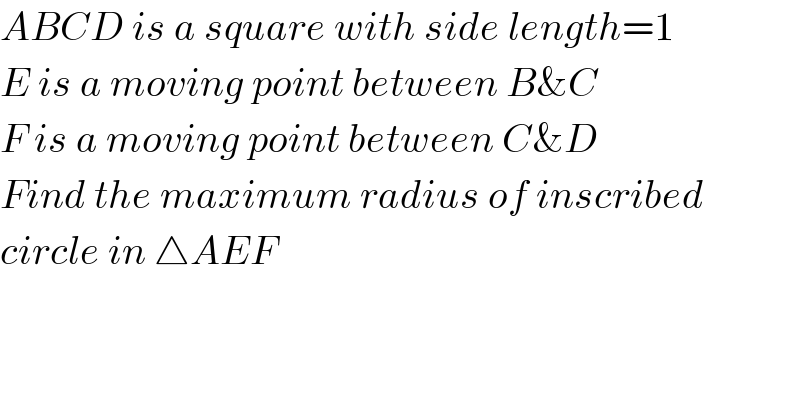Question Number 90456 by Tony Lin last updated on 23/Apr/20

Answered by mr W last updated on 23/Apr/20

Commented by Tony Lin last updated on 24/Apr/20

Answered by ajfour last updated on 24/Apr/20

Commented by ajfour last updated on 24/Apr/20
![∠EAG=(π/4)−θ , AE=sec θ 2φ=(π/4)+θ ⇒ φ=(π/8)+(θ/2) EG=AEcos (2φ) = sec θcos ((π/4)+θ) r=EGtan φ r =(1/( (√2)))(1−tan θ)tan ((π/8)+(θ/2)) tan (π/8)=(√2)−1 let tan (θ/2)=t r=(1/( (√2)))(1−((2t)/(1−t^2 )))[((t+(√2)−1)/(1−t((√2)−1)))] say (√2)−1=a r(√2)=(((1−t^2 −2t)(t+a))/((1−t^2 )(1−at))) = ((−{t^3 +(a+2)t^2 +(2a−1)t−a})/(at^3 −t^2 −at+1)) ((d(r(√2)))/dt)=0 ⇒ (at^3 −t^2 −at+1){3t^2 +2(a+2)t+(2a−1)} +(3at^2 −2t−a){t^3 +(a+2)t^2 +(2a−1)t−a}=0 ⇒ (a+1)^2 t^4 +4a^2 t^3 −2(a^2 +1)t^2 −4t+(a−1)^2 =0 with a=(√2)−1 , appropriate t=0.08197 ⇒ θ_0 ≈9.3721° r =(1/( (√2)))(1−tan θ_0 )tan ((π/8)+(θ_0 /2)) ⇒ r_(max) ≈0.3032](https://www.tinkutara.com/question/Q90491.png)
Commented by Tony Lin last updated on 24/Apr/20

